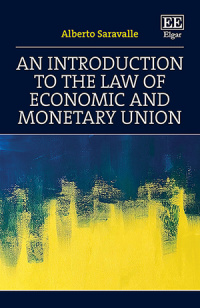Hardback
An Introduction to the Law of Economic and Monetary Union
This incisive book is an accessible guide to the laws and policies relating to economic and monetary union (EMU). Providing a rich, multidisciplinary analysis, it combines historical, legal and economic perspectives to offer a detailed understanding of how EMU has developed since its inception and how it works in practice today. This book will be a valuable reference for those teaching and studying advanced courses on EU law, as well as courses that cover the economic history of EU integration.
More Information
Critical Acclaim
Contents
More Information
This incisive book is an accessible guide to the laws and policies relating to economic and monetary union (EMU). Providing a rich, multidisciplinary analysis, it combines historical, legal and economic perspectives to offer a detailed understanding of how EMU has developed since its inception and how it works in practice today.
Alberto Saravalle begins with an overview of the history of EMU, alongside a theoretical analysis of its regulatory framework and development. He then discusses the events of the European sovereign debt crisis, examining the measures taken by EU institutions such as the European Central Bank, as well as the responses of the Member States and the impact of economic policies they adopted as a result. Finally, he analyses recent proposed reforms to EMU and its possible future evolution, including a discussion of the effects of the Covid-19 pandemic on Member States’ willingness to participate in further reform and integration.
This book will be a valuable reference for those teaching and studying advanced courses on EU law, as well as courses that cover the economic history of EU integration. It will also be useful to practitioners, government officials and policy-makers wishing to familiarise themselves with the complex functioning of EMU.
Alberto Saravalle begins with an overview of the history of EMU, alongside a theoretical analysis of its regulatory framework and development. He then discusses the events of the European sovereign debt crisis, examining the measures taken by EU institutions such as the European Central Bank, as well as the responses of the Member States and the impact of economic policies they adopted as a result. Finally, he analyses recent proposed reforms to EMU and its possible future evolution, including a discussion of the effects of the Covid-19 pandemic on Member States’ willingness to participate in further reform and integration.
This book will be a valuable reference for those teaching and studying advanced courses on EU law, as well as courses that cover the economic history of EU integration. It will also be useful to practitioners, government officials and policy-makers wishing to familiarise themselves with the complex functioning of EMU.
Critical Acclaim
‘Without any rhetoric or ideological bias toward European integration, and in admirably clear language, the author demonstrates that the European reaction to the Covid epidemic has opened the long precluded way to the autonomous fiscal capacity with adequate resources of the Union. The dreamy goal of the Founding Fathers – an ever closer union between our States – is back, and affects the actual prospects of the future Europe. A book recommended to europhile and eurosceptic readers alike.’
– Giuliano Amato, former Prime Minister of Italy and Vice President of the Convention on the Future of Europe
‘I learned a lot reading this very comprehensive book. I highly recommend it to anyone wanting to (better) understand the complex legal order on which EMU is based.’
– André Sapir, Université Libre de Bruxelles, Belgium
– Giuliano Amato, former Prime Minister of Italy and Vice President of the Convention on the Future of Europe
‘I learned a lot reading this very comprehensive book. I highly recommend it to anyone wanting to (better) understand the complex legal order on which EMU is based.’
– André Sapir, Université Libre de Bruxelles, Belgium
Contents
Contents: Introduction 1. Economic and monetary union 2. The Stability and Growth Pact and the other rules of fiscal surveillance 3. The Fiscal Compact 4. Financial assistance and crisis resolution mechanisms 5. The ECB’s non-standard measures 6. The sovereign debt crisis 7. The Italian predicament 8. Austerity policies before national and EU courts 9. Eurexit 10. Reform projects 11. The impact of the Covid-19 outbreak Index




